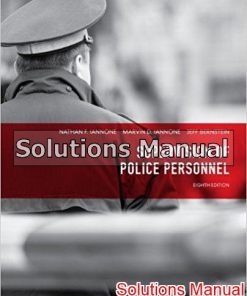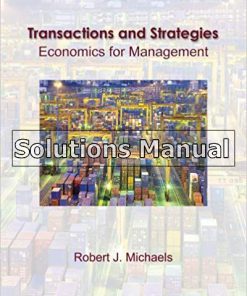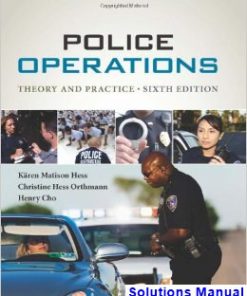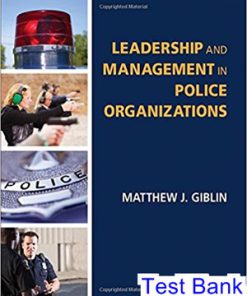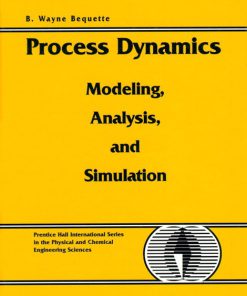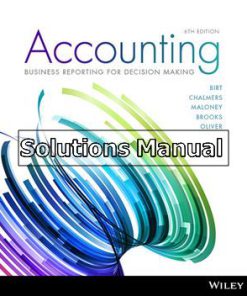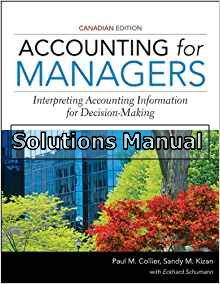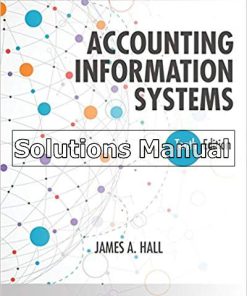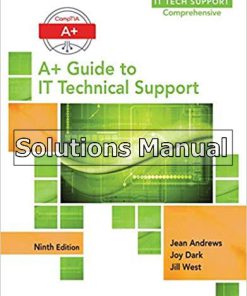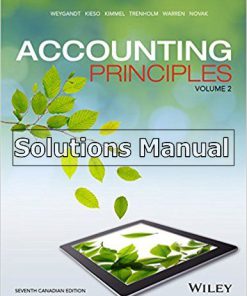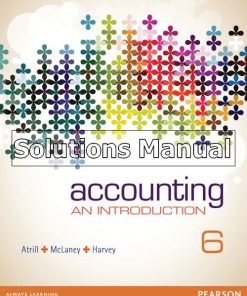Police Crime Control Strategies 1st Edition Larry Hoover Solutions Manual
$26.50$50.00 (-47%)
Police Crime Control Strategies 1st Edition Larry Hoover Solutions Manual.
You may also like
This is completed downloadable of Police Crime Control Strategies 1st Edition Larry Hoover Solutions Manual
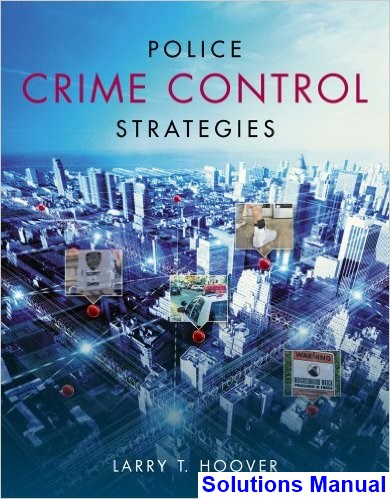
Product Details:
- ISBN-10 : 1133691625
- ISBN-13 : 978-1133691624
- Author: Larry Hoover
POLICE CRIME CONTROL STRATEGIES is a practical, realistic, one-of-a-kind book that provides readers with a balanced assessment of approaches to police crime reduction. Written by an expert in the field of law enforcement, this book covers the strengths and weaknesses of a variety of approaches including crime-specific, community-oriented, problem-oriented, hot spot targeting, concentrated patrol deployment, broken windows enforcement, and intelligence-guided. Opening chapters trace the accumulating evidence for the substantial impact upon crime that focused police efforts can have. Community and problem-oriented programs are reviewed in the context of their employment for crime reduction. State-of-the-art strategies are organized by three targeting foci: geographic, offense, and offender. The role of investigative units in proactive crime reduction is critically assessed and Compstat as a framework receives special attention. Also discussed are crime strategy meetings, and staffing and deployment for crime control. Care is taken to review both the successes and failures of structured efforts both in suburban environments and major cities so that readers are provided with an unbiased overview of policing in the real world.
Table of Content:
- Ch 1: Police Crime Control Strategy Development
- Key Terms
- Learning Objectives
- Introduction
- The First Perspective: A Chronology of Police Strategy Development
- The Second Perspective—Characteristics of Major Strategy Initiatives
- Implications for Strategy
- Summary
- Review Questions
- Real-World Scenarios
- Application Activities
- Coursemate
- References
- Ch 2: The Police Effect on Crime
- Introduction
- Key Terms
- Learning Objectives
- Do the Police Make a Difference?
- Crime Rates Since 1992
- The Police and the Drop in Crime
- Our Research Legacy: A Brief Synopsis Pre-2000
- Conclusions from Our Research Legacy
- Confirming the Legacy: Post-2000 Research
- Implications for Strategy
- Summary
- Review Questions
- Real-World Scenarios
- Application Activities
- Coursemate
- References
- Ch 3: The Role of Community Policing
- Key Terms
- Learning Objectives
- Introduction
- Misuse of the Community Policing Concept
- Appropriate Models of Community Policing
- The Effect of Inappropriate Terminology
- Community Policing Evaluations
- An Alternative Goal—Citizen Satisfaction
- Limitations on Community Policing Validation
- Implications for Strategy
- Summary
- Review Questions
- Real-World Scenarios
- Application Activities
- Coursemate
- References
- Ch 4: Focusing Community Policing and Problem-Solving on Crime Reduction
- Key Terms
- Learning Objectives
- Introduction
- Research Evidence: An Irresolvable Problem
- Models of Neighborhood Deployment
- The Question Remains: Rhetoric or Reality
- Community Policing
- Problem-Oriented Policing
- Implications for Strategy
- Summary
- Review Questions
- Real-World Scenarios
- Application Activities
- Coursemate
- Endnotes
- References
- Ch 5: A Typology of Crime Reduction Strategies
- Introduction
- Key Terms
- Learning Objectives
- Required Attributes for Effective Crime Strategies
- Deriving Enforcement Strategies
- Implications for Strategy
- Summary
- Review Questions
- Real-World Scenarios
- Application Activities
- Coursemate
- References
- Ch 6: Geographic Targeting Strategies
- Key Terms
- Learning Objectives
- Introduction
- Crime Concentration
- Efficacy of Hot Spot Strategies
- Residential Neighborhoods
- High-Crime Commercial Locations
- Camera Surveillance
- Foot Patrol
- Implications for Strategy
- Summary
- Review Questions
- Real-World Scenarios
- Application Activities
- Endnotes
- Coursemate
- References
- Ch 7: Offense Targeting Strategies
- Key Terms
- Learning Objectives
- Introduction
- Bait Property
- Directive Responsive Patrol
- Tactical Patrol
- Multiple Concurrent Approaches
- Specification
- Pawn Shop Monitoring
- Other Stolen Goods Markets
- Offense Clusters
- Drug Market Crackdowns
- Implications for Strategy
- Summary
- Review Questions
- Real-World Scenarios
- Application Activities
- Coursemate
- References
- Ch 8: Offender Targeting Strategies
- Key Terms
- Learning Objectives
- Introduction
- Broken Windows Enforcement
- Undercover Surveillance
- Probation/Parole Partnerships
- Gang Disruption
- Implications for Strategy
- Summary
- Review Questions
- Real-World Scenarios
- Application Activities
- Coursemate
- References
- Ch 9: Compstat and Crime Control
- Key Terms
- Learning Objectives
- Introduction
- Defining Compstat
- Development of the Compstat Model
- Components of the Compstat Process
- Compstat Conflict with Community Policing
- Evaluation of Compstat Effectiveness
- Compstat as a Management Approach
- Implications for Strategy
- Summary
- Review Questions
- Real-World Scenarios
- Application Activities
- Coursemate
- References
- Ch 10: Conducting Crime Strategy Meetings
- Introduction
- Key Terms
- Learning Objectives
- Characteristics of Crime Strategy Meetings
- Data Analysis Format
- Role of Crime Analysts
- Efficiency Improvement
- Tactics
- Implications for Strategy
- Summary
- Review Questions
- Real-World Scenarios
- Application Activities
- Coursemate
- References
- Ch 11: The Resurrection of Sherlock Holmes
- Introduction
- Key Terms
- Learning Objectives
- Expectations Within the Profession
- The Productivity Issue
- Research on Investigative Effectiveness
- The Immediate Future: DNA and Surveillance Cameras
- Implications for Strategy
- Summary
- Review Questions
- Real-World Scenarios
- Application Activities
- Coursemate
- Endnotes
- References
- Ch 12: Staffing for Crime Control
- Introduction
- Key Terms
- Learning Objectives
- The Value of Patrol Models
- Patrol Staffing
- Investigative Staffing
- The Effect of Global Positioning System Tracking
- Discretionary Police Resources
- Difficult Choices
- The Pervasive Comparative Statistic: Police-to-Citizen Ratios
- Implications for Strategy
- Summary
- Review Questions
- Real-World Scenarios
- Application Activities
- Coursemate
- Endnotes
- References
- Ch 13: Deployment for Crime Control
- Introduction
- The Multiple Goals of Deployment
- Key Terms
- Learning Objectives
- The Role of Patrol in Crime Control
- The Future of Community Policing
- Implications for Strategy—And a Personal Note
- Summary
- Review Questions
- Real-World Scenarios
- Application Activities
- Coursemate
- Referencese
- Ch 14: Limitations on the Police Role
- Introduction
- Key Terms
- Learning Objectives
- The Import of Emergency Standby
- Emergency Standby as an Organizational Fundamental
- The Human Factor—Recovery Time
- The Need for Professional Judgment
- Implications for Strategy
- Summary
- Review Questions
- Real-World Scenarios
- Application Activities
- Coursemate
- References
- Ch 15: Evaluating Strategic Impact
- Introduction
- Key Terms
- Learning Objectives
- Crime Complexity
- The Import of Research
- An Agenda
- Separating Science from Advocacy
- Respecting Our Heritage
- Learning from the Physical Sciences
- Implications for Strategy
- Summary
- Review Questions
- Real-World Scenarios
- Application Activities
- Coursemate
- References
- Glossary
- References
- Index
People Also Search:
police crime control strategies larry hoover
police crime control strategies 1st edition larry hoover
police crime control strategies
police crime control strategies 1st edition
police crime control strategies 1st edition download scribd
police crime control strategies 1st edition solution manual download pdf

